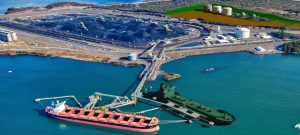
Trigon Pacific Terminals’ Berth 2 Beyond Carbon project (CNW Group/Trigon Pacific Terminal Limited)
PRINCE RUPERT – Prince Rupert’s Trigon Pacific Terminals Limited (Trigon) announced a $75-million award from the federal National Trade Corridors Fund to enable a major expansion and near doubling of export capacity, and also support Trigon’s well-advanced diversification strategy.
“With this federal support, we’ll be able to accelerate the construction of the second berth at our terminal – the $163-million B2BC or Berth 2 Beyond Carbon project,” says Trigon President and CEO Rob Booker. “This project will make Trigon an even more valuable connection point between Western Canadian exporters and rapidly expanding Asia-Pacific green-energy market opportunities.”
“The B2BC project not only solidifies Trigon’s role as a driver of the global trade through the Port of Prince Rupert, but is also a positive and encouraging step forward towards a more sustainable future for everyone,” said Harold Leighton, Metlakatla Chief Councillor and CEO of the Metlakatla Development Corporation.
B2BC is a keystone of Trigon’s diversification strategy and will help enable accelerated energy transformation in Canada and globally, Booker says. The second berth has been designed specifically to enable a shift over time towards handling green energy exports, such as hydrogen-based fuels.
“Trigon’s B2BC project is a key part of the journey of transformation – creating opportunity for our people, for Prince Rupert and for many other communities around the globe who will benefit from the planned green-energy exports,” said Garry Reece, Mayor of Lax Kw’alaams.
“Canada has the potential to be a major player in global hydrogen markets, but we need to move quickly to capitalize on this incredible opportunity,” says Booker. “This federal support will help ensure we will have the export infrastructure needed to secure early-mover advantage. And that in turn will position us to fully leverage emerging competitive advantages such as those in the Edmonton Region Hydrogen HUB.”
The B2BC project will increase Trigon’s throughput capacity from 18.5 million tonnes to an estimated 33.5 million tonnes annually. It will also reduce wait times for vessels by optimizing the configuration and efficiency of existing berthing infrastructure, and will better leverage the CN northern rail corridor that serves the terminal – contributing to improved supply chain stability.
B2BC is fully permitted with construction getting underway this fall and the first product “over the dock” targeted for 2026. Within a five-year timeframe, the project is anticipated to drive annual economic growth of $1.2 billion, with expanding socio-economic benefits in the longer term.
Trigon’s existing berth is purpose-built to handle today’s commodity mix, which predominately includes steelmaking and thermal coal and petroleum coke. Construction of B2BC will enable continued operation of the terminal, and employment of its workforce, while providing a dedicated platform for alternative and clean energy exports.
The berth has been designed for multiple commodities including hydrogen-as-ammonia , renewable and bio-fuels, methanol/ethanol or additional liquefied petroleum gas, and potentially hydrogen itself. It will also create capacity at the existing berth for wood pellets and biomass handling, and potentially other bulk exports such as grain, potash and mineral concentrates (including copper, which is integral to electrification). Trigon’s site encompasses ample space for the development of land-side storage and handling areas that may be required.
Hydrogen production, shipping and use – for purposes such as electricity generation and fueling transportation – is increasingly seen as a crucial element of decarbonization strategies. Canada has significant expertise and production potential relating to both blue hydrogen, using natural gas combined with carbon capture technologies; and green hydrogen, produced through the electrolysis of water using renewable energy sources.
Trigon has been involved in extensive exploration in recent months of hydrogen-as-ammonia export opportunities, including well-advanced discussions with potential Western Canadian producers and Asian buyers, as well as with other key supply chain partners. Early-stage commercial agreements are in place between Trigon and multiple potential business partners with an interest in the production and shipment of ammonia.
The National Trade Corridors Fund (NTCF) is a federal government initiative intended to support growth in or generation of new overseas trade flows, as well as to improve the fluidity and performance of Canada’s transportation system.
Trigon Pacific Terminals Limited is a multi-commodity bulk and liquefied gas export terminal at the Port of Prince Rupert. With a skilled workforce and proven operational excellence, it is a key link between Western Canadian commodity producers and their Asia-Pacific customers. Privately owned – with equity positions held by the Coast Tsimshian First Nations of Lax Kw’alaams and Metlakatla – Trigon is committed to transformational growth strategies aligned with global energy and climate-related imperatives.
Trigon and the Hydrogen Export Opportunity began operations in 1983 as a federal Crown Corporation, privatized in 2019, with partial ownership by two Indigenous Nations. Formerly known was Ridley Terminals Inc., Trigon rebranded earlier in 2022 to better reflect its current ownership and diversified vision for growth
The Hydrogen Export Opportunity: A global market valued at up to $11.7 trillion by 2050.
- Hydrogen and hydrogen-as-ammonia are widely seen as among the most promising emission-free fuels with potential to displace significant volumes of fossil fuels across diverse applications.
- The International Energy Agency has identified hydrogen and hydrogen-based fuels as a key pillar of global efforts to reach net-zero carbon emissions; suggesting that under a net zero emissions scenario it could account for 10 per cent of total final energy consumption by 2050.
- Canada, British Columbia and other provinces are among a growing number of jurisdictions around the world to have formal strategies relating the production, acquisition and deployment of hydrogen, and to the associated economic opportunities.
- Japan was first with such a strategy, and continues its aggressive efforts to secure significant hydrogen supplies and advance their commercial application.
- Earlier this year, for example, Japan’s biggest power generator (JERA) launched an international procurement process through which it intends to buy 500,000 tonnes of ammonia annually beginning in 2027 under long-term contract.
@Trigonbc.com




